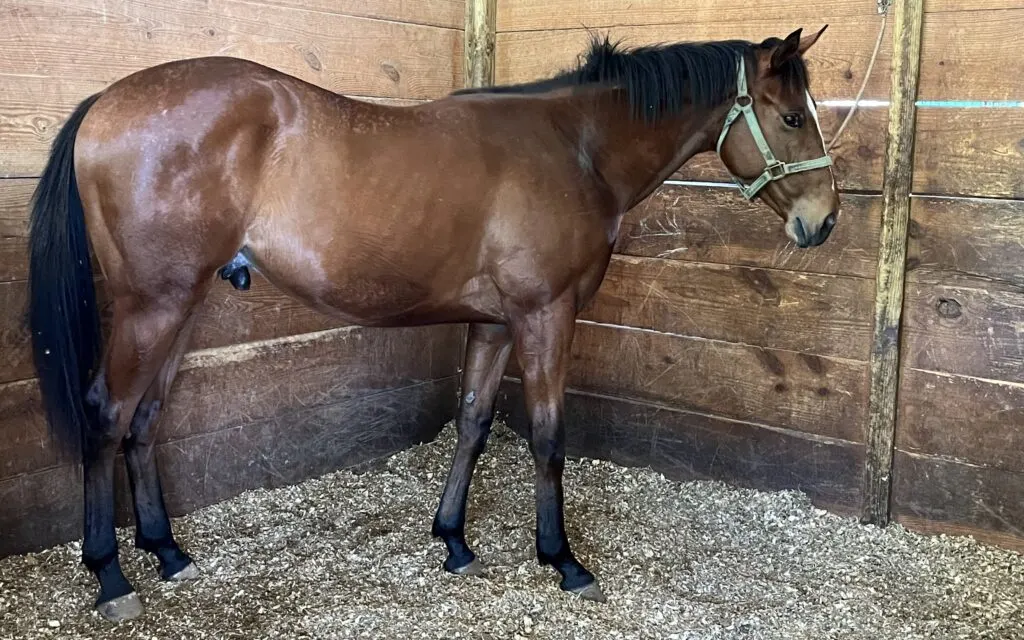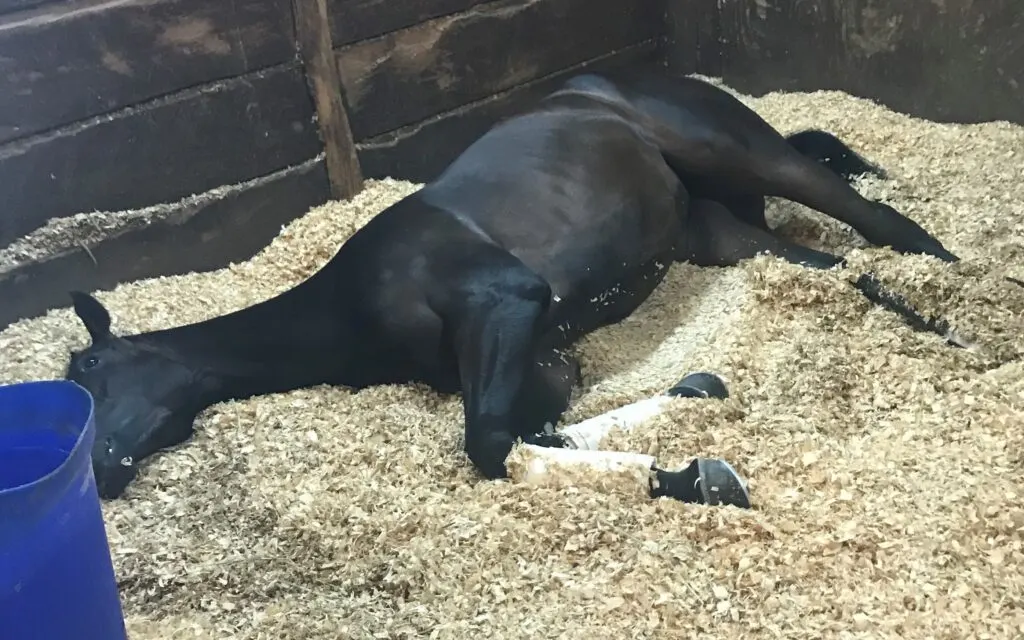Last updated: December 16, 2023
My son is drawing plans for his new horse barn and knows that having the correct size stall is critical. So he researched horse stall sizes to ensure his horses had the room they need without wasting space and money.
The standard stall size for an average-sized horse is twelve feet by twelve feet. Large horses, stallions, and broodmares need larger stalls. If a horse is over sixteen hands, they need a stall fourteen by fourteen feet. Draft horses, stallions, and broodmares often require stalls sixteen by sixteen.
Horse owners often design horse barns to look good. However, if you intend to keep your horse in a stall for extended periods, you must build stalls suitable for your horse.

Choosing the right size horse stall
Once you’ve decided to make the step to purchase a horse, you will need to decide on how to stable it. This may include a barn of some sort, and if so, you will need to figure out how large the stalls in it should be.
Horse stalls aren’t really a one size fits all sort of arrangement. There are rules of thumb, but they change by size and by what the horse will be doing. Stall size also depends on how long the horses will be staying inside.
Rules of thumb
The industry standard size for a horse stall is twelve feet by twelve feet. The standard is based on the average horse’s size, which is about fifteen hands and a thousand pounds, give or take a few. Most of the time, it will work for a horse of that size.

Larger horses need larger stalls. The next size up, say sixteen to seventeen hands, means you would be looking at a stall of at least fourteen by fourteen… and that’s just if it’s for stabling. The horses in this group are called warmbloods.
Draft horses need at least sixteen by sixteen. So does any horse that is going to be in a stable for long periods of time. Horses prefer being out in the open, and small stalls will equal claustrophobia to our equine friends.

Breeding horses
While backyard breeding is seriously not recommended, understanding what is needed for horses for this purpose is necessary. You don’t want to put a stallion in a small stall. They are full of energy and need pacing room.
For a stallion, the stall should be at the minimum sixteen by sixteen or twelve by twenty-four. The same is needed for a pregnant mare about to give birth. The extra space allows the mare to get up and down as required and the stallion to have the area he needs.
One thing that is often done for a pregnant mare is to create a twenty-four by twelve-foot stall by removing a temporary wall between two standard twelve-foot stalls. This allows you to use it for other horses and weaning foals.

Weaning is often done in the fields, with the foal in one field and the mother in the next field over. The fence prevents the foal from nursing. However, not all foals are ready to be weaned at a time when the weather is cooperating.
Another benefit of removable partitions is that half the divider can be removed or folded in half so the foal and mother can be together, but the foal can’t nurse. There are other ways of handling this problem, but the divider is useful for more than just weaning.
When a horse is ill or injured and needs to be on stall rest, a regular-sized stall will likely drive it nuts. A larger stall option will help make the horse’s experience a little less stressful. That, in turn, will make it less stressful for you.
Stall height
A lot of people focus most of their concerns on the width and depth of a horse stall. Height is also a consideration, and it changes based on size, just like the other dimensions. The standard size is eight feet, with headroom above that. The actual ceiling should be at least ten feet, if not taller.
Why should the stall’s walls be lower than the ceiling? Air circulation is the primary consideration here. Good circulation and ventilation of the barn are essential, not only for the well-being of the animals but also for those who work in the barn.
You may wonder why the ceiling needs to be so high. Horses are prey animals and can get spooked readily. When that happens, they may rear or kick with their back legs. You’ll want the stall to be tall enough so that the rearing horse doesn’t bang its head on something.
That also means that any lighting over the stall has to be over that height. Other equipment might be needed, but make sure there is plenty of headroom, just in case. Naturally, taller horses need a higher ceiling.
When it comes to the height of the stall walls, the same thing needs to be considered. The walls have to be tall enough that the rearing horse won’t get hung up on them. Some horses may need a ten-foot wall to protect them from that problem.

Don’t forget the importance of stall doors.
Like everything else about a stall, there are the industry standards, and then there is the horse in question. The industry standard is a four-foot-wide opening. Swinging doors open to the aisle so that if the horse winds up stuck close to the door, it is easier to get in there and help it up.
Massive horses may need a larger door. The reason for that is that it needs to be wide enough for both you and the horse to enter simultaneously. The opening needs to be wide enough, not just for the horse but also for the person taking the horse inside.
We use nylon strap webbing doors for our well-mannered horses. They are easy to install and use. The webbing straps allow better ventilation than solid doors and give the animal an open feel.
However, strap doors aren’t suitable for all horses. Amazon sells the Weaver stall guard; you can click here to see what they look like.

What about the stall flooring?
If you are planning on an earthen floor, please let me dissuade you unless you build the barn floor high so water doesn’t run in. Been there, done that, and I won’t do it again.
Of course, the stall in question wasn’t mine, nor did I build it. However, let me tell you that it gets nasty. But clay stall floors work well when the floor is built high, and proper bedding is put down to absorb urine.
There are a few options you can use for bedding; we use wood shavings because we buy them in bulk from a sawmill. However, we’ve recently discussed switching to bedding pellets; they are more effective and last longer but are also more expensive.
Many horse stalls are made of concrete. Yes, bare concrete can be hard on the horse. Raw concrete is hard on horses’ legs and often causes rubbing sores when they lie down. However, things can be done, such as covering the surface with a rubber mat and deep bedding material. Concrete floors don’t make urine pits.
When planning your first barn, make sure to do some measurements on your horse. You’ll want to know the height at the withers, weight, and width. You’ll also want to have an understanding of the horse’s temperament. That way, you can build the best barn for your needs.

Stall wall construction
In our area, barns are often constructed of cinder blocks. This is ok, except if the blocks are unprotected, a horse easily kicks a hole in the bricks. To prevent this, we cover the blocks with two-inch boards up to five feet from the floor.
Horse stall walls should be sturdy enough to withstand a kick and the weight of your animal leaning against it. It should not have any exposed nails, wires, or other protrusions that could injure your animal.
I use two-by-six-inch boards in our barns and attach them with screws to easily replace broken ones. Inevitably, a horse will find a way to break one.
Conclusion
The main considerations when designing your horse’s stall are comfort and safety. Below is a helpful video that covers the basics of horse stalls and why a horse needs a roomy stall.
Below is a YouTube video that discusses stall sizes for various horses.
FAQ
1. Can you use concrete for a horse stall floor?
Yes, you can use concrete for stall floors, but you need to take some precautions to make it suitable for your horse. Concrete has no give and, over time, can damage your horses’ feet and legs.
2. What do I need to have in a horse stall?
Horse stalls need buckets for water and grain, a hayrack, and tie rings. The stall design should provide adequate ventilation, a suitable flooring material, be well-lit, and have a door or gate that is wide and safe.
3. What bedding material should I use in my horse stalls?
I recommend using pine shavings; they’re readily available, reasonably priced, absorb moisture well, and are easy to clean. I’ve tried different types of bedding and always go back to pine shavings.
4. Do I have to have a barn for my horse?
A barn is not required to own a horse, but they should have shelter to escape the elements. In the summer, they need shade; in the winter, they need a place to block frigid wind, snow, and rain. Wild horses don’t have barns but typically find a natural shelter when they need it.
5. What’s the best fan to use in a horse stall?
There are many good fans you can use for horse stalls. Just make sure the fan you choose has an enclosed motor and a wall-mount bracket. Barns are dusty places, and fan motors that aren’t enclosed draw dust into their motors and fail relatively quickly.
